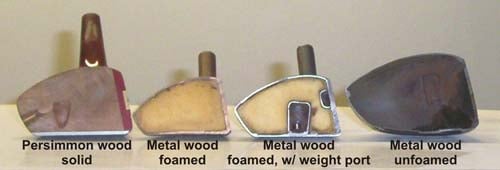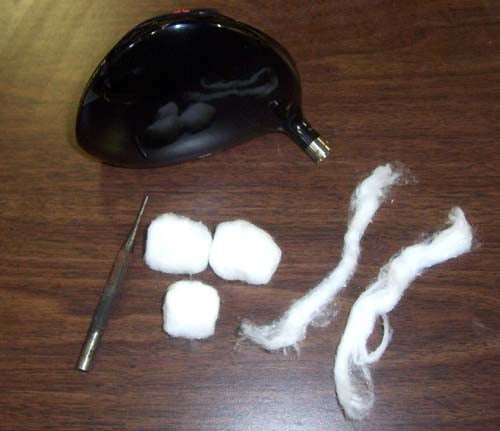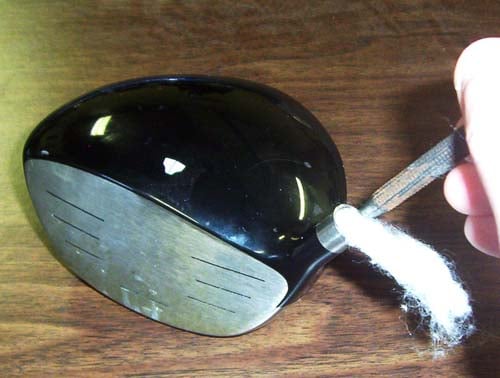How to Quiet a Driver’s Sound
How to quiet a driver’s sound by “Cottoning” it
Do you have a driver that you love, but the sound is so high pitched that your playing partners have started to play without you? Or every time you hit the ball off of the tee it reminds you of the sound of a little league baseball game? OK, you get the hint, your driver is loud as heck and you want to do something about it before you get arrested for disturbing the peace.
Many golfers might not realize this, but as drivers have become larger and larger up to the point they are today, the head weight hasn’t changed compared to those puny little drivers we (us old folks) played growing up. Two things occurred to make this possible. First the materials became lighter and stronger and secondly the walls have been stretched thin to the max. Depending upon the shape and wall thickness in certain areas of the club, a driver’s sound at impact can range somewhat from muted to sounding like a cowbell.
And remember a very important fact – sound is “feel”. Unfortunately there is no way to please every golfer. What one person claims is music to one’s ear; the next golfer may be totally turned off by it so engineering a particular sound into a driver is becoming a more important factor into the design.
The Days of the “Thud”
For years after the advent of the “metal” wood (1979), the hollow heads were foam filled. The reason was two-fold. One was to prevent the faces from caving in. Secondly and most importantly was to dampen the sound at impact as the metal woods were fast replacing wooden woods whose sound what muted or more of a “thud” sound. That lightweight density foam added a good percentage of weight in those heads too.
Over time manufacturers began to realize the stainless steel drivers and fairways would hold up quite well without the foam and as a result the clubhead could be made larger after the weight savings. As a result, clubheads became much more forgiving on off-center shots. And yes, the complaint was those foamless heads made a louder pitch as impact, but over time that became the norm.
Cotton
Now back to our potential problem of reducing the sound of a driver. We could look back at our past and consider foam filling the heads. Well that is not exactly an option today as lightweight density foam could easily add 20g back to these voluminous titanium driver heads. And for you do-it-yourselfers, foam filling an existing clubhead is messy. My old workshop had foam that exploded out of one club covering the ceiling and one wall during an experiment.
One alternative is cotton and it is cheap, readily available and easy to do. I think I have been experimenting with “cottoning” metal woods since the first foamless head appeared. The weight of a single cotton ball is @ 6/10ths of a gram and it doesn’t take too many to alter the sound. The key is getting it into the head.

Getting started
First the shaft needs to be safely removed using a puller (assuming it is graphite-shafted). Next, the plastic stop at the bottom of the hosel needs removed if it doesn’t come out during the shaft removal process. The stop is there to prevent epoxy from entering the head and causing a rattle at a later date.
To remove a plastic hosel stop it is as simple as using a hand drill with a small drill bit (1/8”). The bit may catch and pull the stop right out or at least provide relief to use a thin object to fish it out. It is best not to use a large drill bit otherwise you will just end up pushing it into the head. If the hosel stop is metal, then you might not be able to access to hollow chamber to add the cotton. But once you can see access into the head you are ready to start.
It takes a little bit of patience to add the cotton as the first instinct you will have is to try to shove the entire cotton ball down inside the hosel. You will find out soon it only creates a clog and you have to fish it back out and start again.
Let me take a step back and tell you a little trick first. Take a golf ball and tap it on the face of the club while holding onto the hosel. You will hear the pitch of the clubhead. Each time you add a cotton ball inside repeat this step until you get the acoustics you want.

This video will show you what the change of sound is when comparing the same driver heads.
I find it easier to unroll the cotton ball and shred it into strips. That way you can get the cotton started in the hosel and you can push it through the bottom of the hosel with a long narrow instrument. For example, 1/8” pins punch works great. Proceed inserting the cotton balls until you get your desired sound.
Whoa, don’t overdo it!
Each cotton ball you add you are also increases the weight. On a driver you are looking at approximately 1.6g of weight to equal a 1 swingweight point increase. By adding just 3 cotton balls, you will exceed that slightly. Luckily, most golfers have a hard time telling the difference by adding 2-3 swingweights. If you start to add 9 or more cotton balls, then you may want to consider shortening the club after you have time to hit the freshly cottoned driver. Hey, it may be time to re-grip as well.
One word of caution, you can get carried away and add too much. The volume of a driver might allow you to stuff 20 cotton balls inside if you tried. But you may go from one extreme (cowbell) to the other (dead thud). Use them sparingly and use the tap test on the face to test for the sound.
There are always to solutions to virtually any problem. Some clubmakers have resorted to hot-melting material into the head to do the same thing. But for less than $2 at my local pharmacy I can have a whole bag of cotton balls to experiment with. Adding cotton to an existing driver you like but don’t like its’ current sound or pitch at impact is one practical solution.
